Also to be watched, is the strong liquidity drain that the US Treasury will begin to implement in the United States, after agreeing to raise the debt ceiling. In practice, the Treasury to replenish its treasury account near zero due to the protracted debt ceiling negotiations will now start a strong influx of treasury issues. This disbursement, after the agreement, will begin on Monday, and is supposed to ramp up in the second part of June, when the impact of fiscal deadlines will be added to the influx of short-term government issues. On the central bank front, the week will be full of meetings with interventions from monetary authorities in Australia, Canada, India and Poland. All of these institutes must keep interest rates unchanged, and the RBA meeting, which surprised the markets last month with an increase of 25 basis points, will be of particular importance. Finally, today’s OPEC + meeting should be watched, as the market does not expect new cuts, even if the recent drop in oil prices increases the chances of an internal discussion about this option, especially between the two main exporters, Saudi Arabia and Russia.
Another effect of the drain is the increase in the price of short-term bonds. The 6-month Treasury yield rose to 5.5%, the 3-month yield 5.4% and the 2-year yield also continued to rise over the 10-year period: 4.6% versus 3.37%. These moves on the bond front widened the spreads between the US and Germany, driving up the value of the dollar. “Going forward – explains Cesarano – this trend will tend to strengthen, as the drainage grows in June, and it will take hold.”
Inflation has improved in the eurozone thanks to lower energy prices. Core inflation, which is most worrying, fell in May, especially in Germany, Spain and France, and less so in Italy, where services and food ingredients, which are difficult to refrigerate, are more important. However, Christine Lagarde insists that European inflation “remains high” and that “more needs to be done” to reduce it, which means that the ECB will certainly raise interest rates twice more in June and July, while reserving the right to decide in September on basis for future data. Even in the US, data on the labor market performed well last Friday. “The US job market is still strong, thanks to the momentum of services, while manufacturing already appears to be in the doldrums. However, services weigh two-thirds of the economy, so it counts more than manufacturing,” Cesarano said. Next week, watch the data from ISM Servizi, and it is expected to show a slight improvement in May compared to the previous month. “If the number is much higher than expected, it could fuel fears of a more aggressive Fed. Conversely, a lower than expected number should mitigate these concerns but could reopen fears of a recession on the horizon.” Short-term “. The Fed is preparing for a pause to reflect on interest rates for the month of June. the reason? “The official version – explains Cesarano – is that we do this so that we have other data that we can better decide later. However, I think another factor also contributes: at this stage of draining liquidity, if you raise interest rates by increasing yields on bonds Treasury, you risk pushing depositors further to leave their deposits to buy treasury bills, which creates tension and thus problems for banks, particularly regional ones.” – OPEC+ meetings, no production fees
OPEC + meets today in the stage of falling oil prices. However, we don’t expect major surprises, i.e. there shouldn’t be any new production cuts on the horizon. The important thing is to understand the tones spoken by the “big names” in the sector, especially Saudi Arabia and Russia, which are not the same at this stage. The problem, Cesarano explains, is that they agreed to cutbacks and subsidize prices. Saudi Arabia does it and Russia prefers instead to sell more and do whatever it likes with production cuts. Hence the friction between the two.”
There are many Chinese data to watch this week. Monday starts with Caixin Services. Then, on Wednesday, we continue to publish the trade balance for the month of May, which is expected to be clearly in excess. More important will be Friday’s inflation data. Confirmation of a near-zero level, seen recently, would raise expectations about new stimulus measures by the People’s Bank of China. In China, the recovery appears to have lost momentum. Data on manufacturing activity in May was mixed. The manufacturing PMI, which is calculated by the Office for National Statistics, fell to 48.8 points from 49.2 in April, the lowest in five months. The Caixin Index, a specially calculated one that takes more into account small and medium-sized enterprises, instead records different data and shows an expansion of 50.9 points in the industry in May. However, according to Bloomberg, the Beijing government is ready to launch stimulus measures for the real estate sector, which has been in crisis for some time and is an important “engine” for the growth of the dragon economy. This was enough to change the mood of the Chinese financial markets, with the rise of the Shanghai and Hong Kong stock exchanges again, due to expectations that the arrival of stimuli in the real estate sector may be sufficient to resume consumption and investments. – BTP VALORE is trading in Italy
It should be noted the first appearance in Italy, next week, of Btp Valore in Italy. It’s a tool designed by the Treasury for the retail market, ie mainly for small individual savers, and for debt stabilization, in the context that we have upward revisions of our GDP, about 1% in 2023, thanks to lower gas prices and a good start in the first quarter. The two minimum coupons of the value of the BTP, which can be adjusted upwards, will be 3.25% for the first 2 years and 4% for the next 2 years, to which will be added a loyalty bonus of 0.5%, for those who hold the billing locker for 4 years and thus until the due date, which, given the circumstances Currently, it represents an advantage of about 0.25% over a normal 4-year Btp purchase. It will be important to understand how much this new product takes off, to understand how solvable Italy is internally. Today, about 9% of the Italian public debt is in retail hands. If this product does well, it will exceed that quota and thus start going into double digits. (AGI)

“Prone to fits of apathy. Introvert. Award-winning internet evangelist. Extreme beer expert.”









